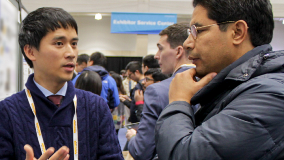Compact optical system achieves achromatic focusing
Jul 8, 2022|Season 4, Episode 12
In this podcast episode, MRS Bulletin’s Sophia Chen interviews Adam Kubec at Swiss startup XRNanotech and research team member Marie-Christine Zdora of the Paul Scherrer Institut about their proof-of-principle of an x-ray achromatic lens. The lens consist of a focusing diffractive and a defocusing refractive optical element that achieves imaging of a range of wavelengths without having to move the sample. The researchers used two different diffractive lenses, one made from nickel and one with gold. To fabricate the refractive lens, they used a nanoscale 3D printing technique known as two-photon polymerization. This work was published in a recent issue of Nature Communications (doi:10.1038/s41467-022-28902-8).
SOPHIA CHEN: Welcome to MRS Bulletin’s Materials News Podcast, providing breakthrough news & interviews with researchers on the hot topics in materials research. My name is Sophia Chen. Your camera uses a lens to focus light bouncing off an object. In order to capture a clear image, that lens is designed to focus all colors, or wavelengths, of light to the same plane. If you’re taking an X-ray photograph, you need a similar lens to focus the light. Previously, though, because of the nature of X-rays, scientists used lenses that could only focus one wavelength of X-ray at a time. Now, Adam Kubec at Swiss startup XRNanotech says they have created the first lens for focusing a range of X-ray wavelengths, known as an achromatic X-ray lens.
ADAM KUBEC: We are the first ones that actually made this type of lens for X-ray applications.
SOPHIA CHEN: Those X-ray applications, for example, include companies that manufacture batteries or computer chips, says Kubec. At these facilities, engineers might use a range of X-ray wavelengths to analyze the quality of these products. Achromatic lenses would make X-ray imaging simpler and more efficient to use. Without them, a user might have to continually realign their sample or the lens when using different X-ray wavelengths, says team member Marie-Christine Zdora of the Paul Scherrer Institut.
MARIE-CHRISTINE ZDORA: So that's really useful then also to have this achromatic lens. So you can really leave everything in place. You don't need to move anything and you still have everything in focus.
SOPHIA CHEN: In addition, the lens could help expand access to X-ray imaging. Currently, researchers either need to apply for access to an X-ray source such as a synchrotron facility, or they must use a laboratory-scale X-ray source, which are more accessible but produce fewer X-rays at a time. Because lab X-ray sources aren’t as bright, they require longer exposure times to get a high quality image. Without the achromatic X-ray lens, scientists must use single-wavelength lenses, which blocks out most of the X-rays and lengthens the exposure time further.
MARIE-CHRISTINE ZDORA: This achromatic X-ray lens is quite important because otherwise you would have to select one wavelength, and you lose a lot of X rays.
SOPHIA CHEN: The lens consists of two main elements. One section is a type of lens known as a diffractive lens, which focuses light through interference. The light passes through a series of concentric circles to constructively interfere at a focus. The other element is a refractive lens, which bends X-rays similar to how a pair of glasses bends visible light. When X-rays travel through one of these elements, different wavelengths focus at a different location. But the team has designed the lenses such that when combined, X-rays ranging from 5.8 to 7.3 kilo-electron volts will all focus at about the same distance away from the lens.
ADAM KUBEC: We can use the two distinct different properties of those two lenses in order to focus it to a single focal plane.
SOPHIA CHEN: Fabricating the diffractive lens, the one made of concentric circles, is a specialty of this group. They’ve made these so-called Fresnel Zone Plates for years. In this project, they used two different diffractive lenses, one made from nickel and one with gold. Their main challenge was fabricating the refractive lens. They used a nano-scale 3-D printing technique known as two-photon polymerization.
ADAM KUBEC: You basically shoot a laser into the material and then instead of the liquid where you started with, you will get this solid structure. So you can really solidify layer by layer this material, which is there. Then in the end, you just wash the material away that is still liquid, and then you have as a result this material, which is solid.
SOPHIA CHEN: They tested the lens in two different ways. In one test, they used X-rays to create an image of a test object made of gold. In the other test, they measured the location of the focus and noted how much it moved for various X-ray wavelengths.
ADAM KUBEC: We were able to show that the image quality, and also the position of the focal plane did not change or that if it changed, but it did change as expected.
SOPHIA CHEN: A future direction of research is to make these lenses focus an even wider range of X-ray wavelengths. The team is also working to make the lenses available to industry. This work was published in a recent issue of Nature Communications. My name is Sophia Chen from the Materials Research Society. For more news, log onto the MRS Bulletin website at mrsbulletin.org and follow us on twitter, @MRSBulletin. Don’t miss the next episode of MRS Bulletin Materials News – subscribe now. Thank you for listening.

